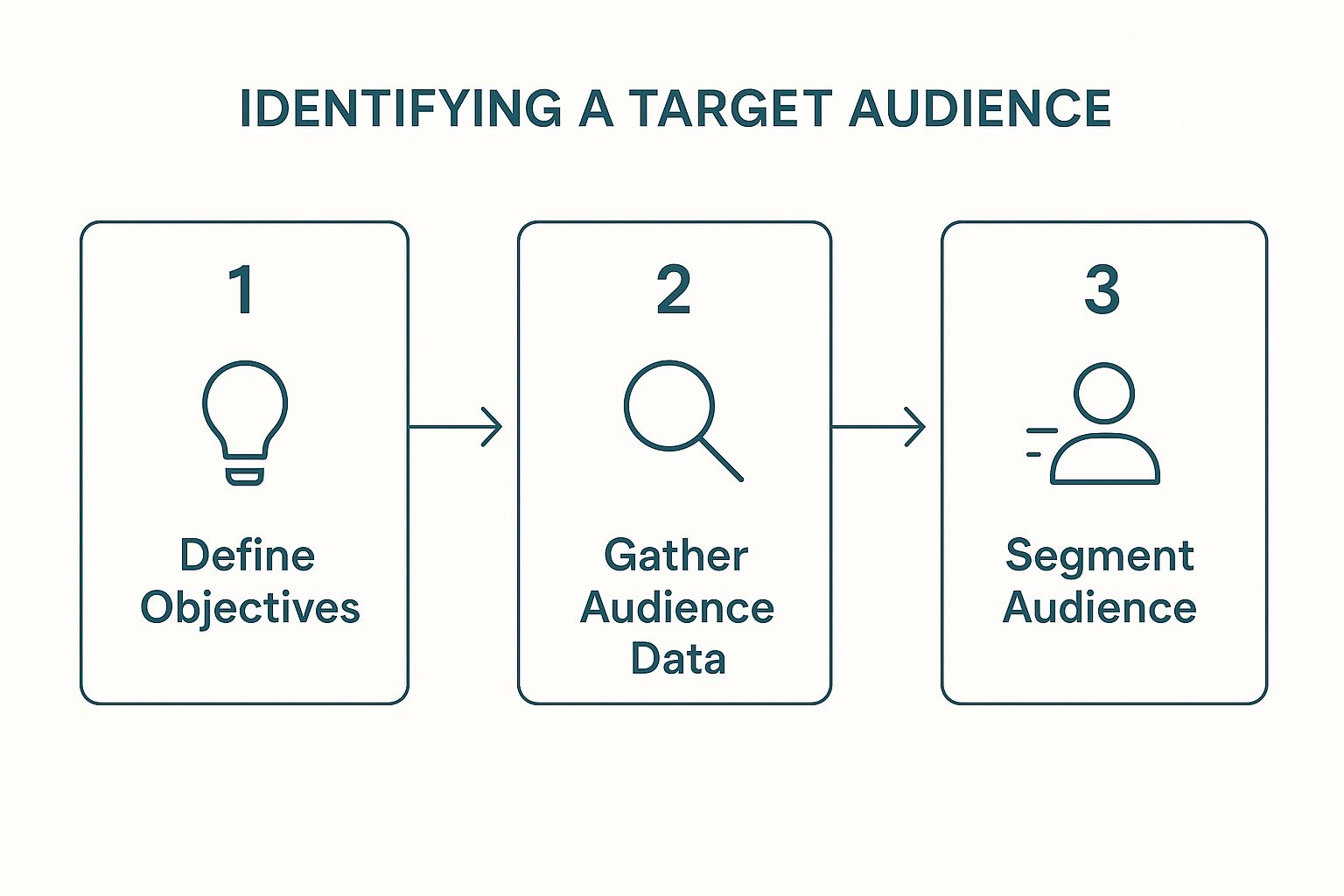
Forget the fluffy marketing guides. As founders, we don't have time for abstract personas. Figuring out your target audience is about finding the specific group of people with a painful, urgent problem you can solve right now. Nail this, and everything from your product to your sales copy falls into place. Skip it, and you’re just guessing.
Stop Guessing, Start Listening: Our Approach at BillyBuzz
Most advice on "knowing your customer" is useless for early-stage founders. At BillyBuzz, we skip the theory and get straight to building a practical Ideal Customer Profile (ICP). This isn't about daydreaming; it's about finding real problems people are already complaining about online.
The first rule is to stop making assumptions. To find those first 10 customers, you have to anchor your strategy in real conversations, not hunches. We learned early that ditching gut feelings for data-driven decisions is the only way to build a GTM strategy that doesn't immediately fall apart.
Start with the Pain, Not the Person
Don't start with demographics. Start with the core pain point your product solves. Then, work backward.
Ask yourself:
- Who feels this pain most acutely?
- Who is actively searching for a solution today?
- Who is willing to pay to make this pain go away?
Answering these questions gives you a concrete hypothesis you can start testing immediately.
This simple visual breaks down how we think about moving from a big goal to a specific customer segment.

As you can see, identifying your audience is a structured journey, not just a one-off task. It's about moving deliberately from broad ideas to specific, actionable groups.
This process can feel overwhelming, so we've boiled our approach down into a simple framework to keep things focused.
Our 3-Step Audience Identification Framework
Here’s the exact framework we use at BillyBuzz to go from a vague idea to a testable customer profile.
| Phase | Objective | How We Do It at BillyBuzz |
|---|---|---|
| 1. Define a Broad Problem | Identify the core issue your product solves without limiting who might have it. | We started with a simple observation: "Manual social media monitoring is a soul-crushing time sink." |
| 2. Find Where It's Discussed | Find online communities where people are actively complaining about this problem. | We went straight to Reddit, Twitter, and Indie Hackers to find real conversations. |
| 3. Form a Testable Hypothesis | Build an initial profile based on the language, job titles, and needs you observe. | Our first hypothesis was: "Bootstrapped SaaS founders handling their own marketing are our people." |
This isn't about getting it perfect on day one. It’s about creating a concrete starting point that you can prove or disprove with real-world feedback.
Look for Clues in Online Behavior
Understanding where potential customers hang out online gives you an incredible advantage. For instance, basic social media demographics can help you focus your energy from day one. In 2025, with over 5.41 billion global users, different platforms have clear age-based skews.
In the U.S., Instagram is huge with younger audiences (76% of 18-29 year olds use it), while Facebook remains a stronghold for older groups (70% usage among 50-64 year olds).
This kind of data is a fantastic shortcut, telling you where to start listening. For us, we quickly realized our early adopters weren't scrolling through Instagram. They were deep in Reddit threads, venting about the frustrations of manual social monitoring. We learned so much from that, we even wrote a guide on how to get customers from Reddit in 2025 detailing our exact tactics.
The goal isn't to create a perfect, polished persona on day one. It's about building a solid, testable hypothesis about who your customer is and where they spend their time. Everything else follows from that.
Go Where Your Audience Lives Online
Your ideal customers are already gathered in digital watering holes, talking, complaining, and sharing solutions. Your job is to find these spots and become a fly on the wall.
At BillyBuzz, we skip the broad market research and go straight to the source. It's less about "market analysis" and more about targeted eavesdropping on the real, unfiltered conversations happening every day.
You need to hang out where your people hang out. This means spending time on Reddit, lurking in niche forums, and joining private Slack or Discord communities. These are the places where people talk openly about their frustrations and needs. Honestly, becoming a silent observer in these spaces is the fastest way to get raw, actionable intelligence.

Our Tactical Listening Posts
We focus our energy where conversations are already happening. Since BillyBuzz is built for founders and marketers, our listening posts are the communities where they go for advice.
Here are our go-to spots:
- Subreddits: We constantly monitor r/saas, r/startups, r/marketing, and r/growmybusiness. These are goldmines for understanding the day-to-day challenges our audience faces.
- Specialized Forums: We also watch discussions on platforms like Indie Hackers and other marketing-specific forums where founders share their growth struggles.
Inside these communities, we don't just browse. We use precise search queries to cut through the noise. Instead of a generic search like "social media," we dig deeper with phrases that reveal intent and pain:
- "how to find customers on Reddit"
- "competitor monitoring tool alternative"
- "tired of manual social listening"
This simple tactic surfaces the exact language our potential customers use, which is invaluable for crafting messaging that actually resonates. To get you started, we've even put together a list of the top 5 subreddits for small business insights that we've found deliver incredible value.
Decoding the Conversation
Once you've found the right communities, your real job begins: analyzing what’s being said. Don't just skim the posts—the real magic is often buried in the comments. That’s where you’ll find people sharing their frustrations, recommending tools, and debating solutions.
The goal here isn't to jump in and start selling. It’s to absorb the language, the pain points, and the existing solutions being discussed. This is how you validate your assumptions with zero outreach.
Keep an eye out for recurring themes. What tools do people keep mentioning (both the ones they love and the ones they hate)? What specific words do they use to describe their problems? This information is the foundation for everything that comes next, from your marketing copy to your product roadmap.
Matching Platform to Demographics
Of course, the platforms you monitor have to align with who you're trying to reach. If your product is for Gen Z, Reddit is a decent start, but you absolutely can't ignore a platform like TikTok.
Right now, 1 in 4 TikTok users is under 25, with the largest user segment being 18 to 24-year-olds. And with 63% of visits coming from mobile, it's clear you'd need a video-first, mobile-centric strategy to connect with them. Check out the latest TikTok demographics on Exploding Topics to see if it makes sense for your ideal customer. This step ensures your listening efforts are actually focused on the places where your future customers are most active.
Craft Actionable Personas, Not Fluffy Bios
Let's be honest: most customer personas are useless. They’re full of stock photos and fluffy details like “enjoys coffee and long walks on the beach,” which do nothing to inform your strategy. As a founder, you need a tool, not a creative writing exercise. This is where you turn all that raw, real-world data into a strategic document.
At BillyBuzz, we build personas that force us to make better decisions. We’ve ditched the fluff and zeroed in on four practical areas that tell us how to talk to people, what to build, and where to find them. A persona isn't about who someone is; it's about what they're trying to do.
This image shows what a traditional persona often includes, touching on things like goals, frustrations, and motivations.

These elements are a decent starting point, sure, but we need to push further to make the persona truly actionable for our marketing and product teams.
The Four Pillars of an Actionable Persona
Instead of getting lost in broad demographics, we distill all our research from those Reddit threads and online forums into these four specific categories. This simple framework ensures every persona we create directly informs how we build our product and reach out to new customers.
- Jobs to Be Done (JTBD): What is this person "hiring" your product to do? For a SaaS founder, it's not "get more leads." It's "find a scalable way to monitor brand mentions without hiring a social media manager."
- Buying Triggers: What event or pain point pushes them to actively search for a solution? It could be seeing a competitor get featured in a viral Reddit thread, or spending an entire weekend manually searching for company mentions.
- Success Metrics: How do they define a "win"? For our founder, success might be "spend less than one hour a week on social monitoring" or "find three high-quality leads from Reddit every month."
- Hesitations: What are their biggest doubts? It could be price ("Is this just another expensive subscription?") or complexity ("Will this be a pain to set up?") or skepticism ("Can't I just do this myself?").
A powerful persona is a summary of motivations and obstacles. It should immediately tell you what messaging will hit home and what objections you need to squash.
This structured approach transforms a pile of messy notes into a clear, strategic guide. If you're looking to apply this level of detail to your own customer outreach, our guide on personalized outreach with AI segmentation dives deep into how you can use these insights at scale.
Our Persona for "SaaS Founder Alex"
Here's an anonymized example of one of our core personas. We call him "Alex." This is what we use internally to guide our messaging and product decisions.
| Category | SaaS Founder "Alex" |
|---|---|
| Job to Be Done | "Find early-adopter customers in niche communities without sinking hours into manual searching." |
| Buying Trigger | "Just saw a competitor get a huge traffic spike from a single Reddit post and realized I have zero visibility there." |
| Success Metric | "Get 5-10 qualified leads from Reddit each month and save at least 8 hours of manual work." |
| Hesitations | "Is Reddit marketing just a time-wasting distraction? Is this tool just another glorified keyword alert?" |
With this, we know exactly how to talk to Alex. Our messaging leads with the pain of missed opportunities, highlights the concrete time-saving benefits, and directly addresses his skepticism about the ROI of Reddit. This is how you turn audience knowledge into a growth engine.
Get on the Phone: Validate Your Assumptions with Real Humans
All the research in the world is just theory until you get on a call. Data and personas give you a starting point, but you have to talk to potential customers and just listen. The point isn’t to sell; it's to understand their world so well that your solution feels inevitable.
We call these "problem discovery" calls. They're where you pick up on the frustrations, the workarounds, and the "I wish someone would just fix this" moments that data can't show you. The best people to talk to are already in those niche subreddits and forums, actively discussing their problems.
How We Get Busy Founders on a Call
Getting a founder on a call is hard. Their inboxes are full, and they can smell a sales pitch a mile away. Our approach is simple and honest, focusing entirely on their expertise.
Here’s the exact template we use in DMs on Reddit, LinkedIn, or forums:
Subject: Quick question about [their industry/challenge]
Hey [Name],
Saw your comment in [Subreddit/Forum] about [specific problem they mentioned]. I'm building something in that space and trying to make sure it doesn't suck.
Would you be open to a 15-min chat next week? No sales pitch, I just want to learn from someone who's actually dealing with this.
Cheers,
[Your Name]
This works because it’s genuine, respects their time, and positions them as the expert. You’re asking for their help, not their money.
How to Run a Problem Discovery Call
Once you're on a call, your job is simple: ask good questions and shut up. You’re there to get them talking about their workflows, their budgets, and what drives them crazy.
We focus on four key areas:
- Their Current Process: "Walk me through how you handle [the problem] right now. What tools are you using?"
- Their Biggest Headaches: "What's the most annoying part of that? If you had a magic wand, what would you fix?"
- The Cost of the Problem: "How much time or money is this issue costing you each month? Have you paid for a tool to try and solve it before?"
- The "So What?" Factor: "What happens if you don't fix this? Is it a minor annoyance, or does it impact revenue?"
These chats are where you strike gold. You might discover a problem you thought was universal is actually specific to one region. For example, think about YouTube's audience, which is projected to hit 2.85 billion. The top market is India with 491 million users, while the U.S. has 253 million. This massive difference shows why you can't assume a one-size-fits-all solution; you have to validate your ideas with people in their specific cultural and market contexts. You can dig deeper into these YouTube user statistics on Global Media Insight.
These conversations will either confirm you’re on the right path or force you to rethink everything. Either outcome is a massive win.
Automate Your Audience Discovery
Manual research is crucial at the start, but it doesn't scale. Once you've validated your assumptions, you need to build a machine that brings opportunities to you. This is how we moved from one-off research projects to a real-time discovery engine at BillyBuzz.
This is where you bridge the gap between manual effort and a scalable system. As you start using smart tools for outreach, understanding how to handle integrating conversion data into ad platforms becomes a game-changer for campaign optimization. The goal is to create a constant, automated flow of high-intent conversations.

Our Internal Alert Setup in BillyBuzz
Inside BillyBuzz, we have a series of alert rules that act as our digital scouts, monitoring specific subreddits, Twitter keywords, and forums for conversations that signal buying intent. We don’t just listen for our brand name; we listen for problems.
Here’s a peek at the exact filters we have running 24/7:
- Competitor Pain: Keywords like “[Competitor Name] alternative,” “frustrated with [Competitor Name],” or “[Competitor Name] pricing.” This flags people who are actively looking for a change.
- Problem-Based Keywords: We monitor phrases like “how to track Reddit mentions,” “find customers on Reddit,” or “social listening for startups.”
- Buying Intent: We set up alerts for signals like “recommend a tool for,” “any suggestions for social monitoring,” or “what do you use for lead gen.”
These alerts get piped straight into a dedicated Slack channel, so our team can jump on relevant conversations in minutes, not days.
The power of automation isn't just saving time—it's achieving a level of speed and consistency that's impossible to replicate manually. You catch opportunities the second they appear.
A Template You Can Steal
To give you something practical, here's one of our most effective alert setups. This shows the specific keywords and source filters we use internally to find potential customers.
BillyBuzz Alert Rule: Reddit SaaS Tool Seekers
| Alert Name | Monitored Keywords | Sources | Action |
|---|---|---|---|
| Reddit SaaS Tool Seekers | "tool to help with", "recommend a SaaS for", "alternative to [Your Competitor]" | r/saas, r/startups, r/marketing | Send alert to #new-leads Slack channel |
This simple rule automates the most soul-crushing part of audience research. Instead of you hunting for them, your ideal customers are delivered right to you, ready for a conversation. This is how you build a predictable, scalable system for identifying your target audience.
Common Founder Questions Answered
After countless conversations with founders, the same questions about defining a target audience keep popping up. These aren't textbook problems; they're the real hurdles we all face. Here are my straight-up, no-BS answers.
How Specific Should My Initial Audience Be?
So specific it feels uncomfortably small.
A vague target like "small businesses" is a recipe for failure. You can't build a single, compelling solution for all of them.
Instead, zero in on something like, "bootstrapped SaaS founders in their first year struggling to use Reddit for customer acquisition." That’s a group with a very specific, urgent pain point.
This isn't about limiting your market. It’s about establishing a beachhead. Find a small, motivated group whose problem you can solve better than anyone else, turn them into fans, and then expand. Most startups die not because their market is too small, but because their initial focus is too broad.
What If My Product Serves Multiple Audiences?
This is a classic trap. If your tool could help both marketing agencies and solo creators, you must pick one to start with. Don't try to serve both.
Each audience speaks a different language:
- Agencies care about team efficiency, client ROI, and scalability.
- Solo creators focus on saving time, community building, and monetization.
Your messaging, features, and marketing channels will be completely different for each. Try to please everyone, and you'll connect with no one. Pick the group you can reach most easily or whose pain is most acute. Nail it with them first, then branch out.
One of the biggest mistakes founders make is trying to be everything to everyone. They dilute their message and resonate with no one. Pick a lane, win there, and then expand.
How Often Should I Revisit My Personas?
Personas are not a "one-and-done" task. They’re living documents.
I recommend revisiting them at two key moments:
- Quarterly: A regular check-in keeps your strategy aligned with what you're learning from real sales calls and customer feedback.
- After any major product shift: When you launch a big new feature or pivot your strategy, your ideal customer might change, too.
This isn't busywork. It's about ensuring you're always solving the most relevant problems for the people who actually pay you.
Ready to stop guessing and start finding high-intent customers on Reddit? BillyBuzz uses AI to monitor relevant conversations and sends real-time alerts, so you can engage with leads the moment they express a need. Start automating your audience discovery today.
